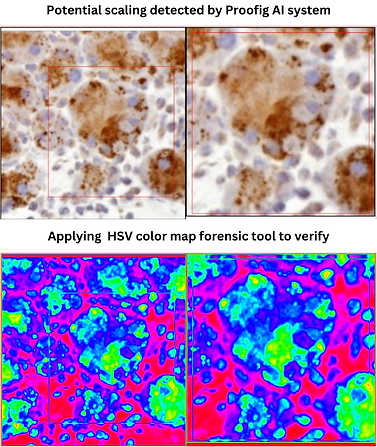Duplication and Reuse Detection: Safeguarding Scientific Integrity with Proofig AI's Duplicate Image Finder

Detecting Duplicate Images with Proofig AI's Duplicate Image Finder
Ensuring scientific integrity is essential to maintaining trust in research. Duplicate images—whether accidental or intentional—can distort data and mislead conclusions. Proofig AI’s Duplicate Image Finder rigorously scans each manuscript image to detect subtle duplications, including overlapping photos and other modifications, thereby safeguarding the authenticity of your scientific work.
Types of Image Duplication & Reuse Detected by Proofig AI’s Duplicate Image Finder
Understanding the various forms of image duplication is crucial for maintaining scientific integrity. Proofig AI's Duplicate Image Finder detects multiple types of duplication and reuse:
Full Duplication Detection
Full duplication Full duplication refers to the reuse of an identical image within a manuscript, often reflecting a lack of proper data management and organization. Such instances can raise questions about the clarity and reliability of the research process.
Description: This misrepresents data by creating the appearance of additional findings when there is only one instance.
Example: An image appearing on both in figure 1 and figure 2, implying two separate observations.
Proofig AI's Detection:
-
Compares each image in the manuscript for exact matches.
-
Allows authors to catch overlooked duplications not easily visible to the naked eye.
Detecting Scaling Issues
Scaling involves resizing an image to make it appear as a different data point.
Description: Resizing can inadvertently present the same data as a new observation due to altered magnification.
Example: Enlarging a section of a microscopy image and presenting it elsewhere as a new image.
Proofig AI's Detection:
-
Analyzes proportional differences between images.
-
Identifies instances where scaling has been applied, preserving data integrity issues.

Identifying Rotated Images
Rotation alters an image's alignment to make it seem visually distinct.
Description: Rotating images can disguise duplication by changing orientations.
Example: Rotating an image 90 degrees to present it as a new observation of the same sample.
Proofig AI's Detection:
-
Detects angular orientation shifts.
-
Flags rotated images to prevent misleading data representation.

Flipped Image Detection
Flipping creates a mirror image, making duplicated data appear different.
Description: Flipping horizontally or vertically can mislead viewers into thinking the image is unique.
Example: A Western blot image flipped horizontally to suggest an additional data point. This can sometimes occur accidentally, as Western blot bands are developed on a semi-transparent membrane that can easily be inverted in different directions during handling.
Proofig AI's Detection:
-
Detects mirrored micro-image patterns that indicate flipping.
-
Flags flipped images to ensure accurate interpretation and prevent potential misrepresentation, whether intentional or accidental.

Overlapping Photos and Partial Overlap Detection
Partial overlap happens when a portion of an image is reused within the same document.
Description: Overlapping photos can imply separate findings or regions of interest.
Example: In microscopy imaging, researchers often attempt to capture different areas of a sample. However, due to the lack of reliable methods to prevent overlap between adjacent areas, overlapping regions may unintentionally suggest additional clusters of cells or tissue. This issue is common and often unintentional but can still pose an integrity concern.
Proofig AI's Detection:
-
Analyzes similarities in smaller cropped areas.
-
Detects overlapping regions to ensure repeated sections are recognized and verified.

Advanced Forensic Analysis Tools: Reinforcing Scientific Integrity
After Proofig AI flags a potential duplication, researchers can use its forensic tools to conduct a detailed analysis and ensure scientific integrity. These tools allow a closer look at flagged duplications, including subtle or modified instances:
-
Color Maps: With options like invert, Jet and Greyscale, color maps enhance intensity variations and highlight overlapping or reused microscopy sections, making duplications more visible.
-
Filters: Various filters, including Emboss, accentuate edges, making rotated or flipped western bands duplications easier to spot.
-
Enhancement Techniques: Tools such as Histogram Equalization adjust contrast to reveal hidden details in duplicated western bands areas, allowing for a comprehensive review.
By applying these tools, researchers can validate flagged images, confirming duplication or ruling out false positives, to ensure accuracy and transparency in their findings.
Beyond duplication and reuse detection, Proofig AI delivers advanced solutions for alteration and manipulation detection, PubMed source plagiarism detection, and AI-generated image detection, supporting integrity across diverse scientific challenges.

Upholding Scientific Integrity with Proofig AI
Maintaining scientific integrity is crucial for trust in research findings. Proofig AI supports researchers by:
-
Offering tools like the Duplicate Image Finder to detect and prevent duplicates.
-
Promoting accuracy and transparency in data presentation.
-
Reinforcing a culture of integrity within the scientific community.
By acting as both a duplicate image and picture finder, Proofig AI ensures comprehensive detection of various forms of duplication.
Conclusion
Proofig AI's Duplication and Reuse Detection feature, powered by the Duplicate Image Finder, is essential for preventing duplicate images and upholding scientific integrity. By integrating advanced detection capabilities into your research workflow, you ensure your scientific publications are accurate and trustworthy. Trust Proofig AI to safeguard the authenticity of your scientific images.
Discover how Proofig AI safeguards scientific research integrity across all capabilities on our homepage
For further information, explore our FAQ about peer-reviewed articles and view pricing for our AI research tool
